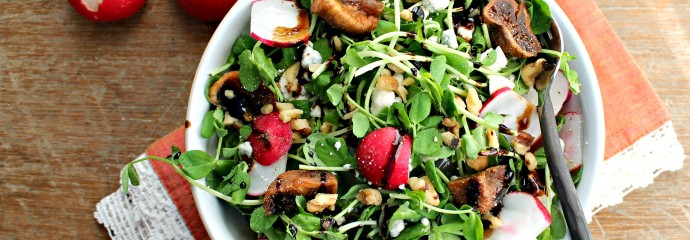
Inspiring Spring Produce
Posted April 21, 2015 | Nutrition & Health Tips, recipes, UncategorizedSpring has finally arrived! The tulips are in bloom, the sun is starting to shine, and the wonderful smells of spring are filling the air. A new season means new seasonal produce options and the opening of farmers markets. Snap yourself out of the winter blues by changing up some of your meals to incorporate more fresh spring produce. This spring produce guide will provide you with new recipes to freshen up your meals and kick start spring! To look for a farmers market in your area visit: http://seattlefarmersmarkets.org/
Artichokes: The edible bud of the thistle flower that have an earthy flavor and meaty texture. Simply steaming the artichoke and adding a squeeze of lemon or a drizzle of butter are easy preparations. The hearts of the artichoke can be chopped and added to salads and pastas. Here are some tips on how to trim and prepare artichokes for cooking. Artichokes have several health benefits that many people are not aware of. They are loaded with antioxidants and phytochemicals that can help with digestion, cholesterol, liver function, and cancer prevention. Artichokes are ranked in the top four for antioxidant containing vegetables and ranked seventh highest overall. While the hearts are the most popular part, the leaves contain the most beneficial nutrients.
Asparagus: They come in three colors green, purple and white. Asparagus can be used pureed in a creamy soups, boiled or steamed and tossed with a light vinaigrette to make a salad, or chopped and baked into frittatas. Learn how to prepare and store them here. Asparagus are a great source of fiber, folate, and vitamins A, C, E, K. The chromium in asparagus helps increase the transport of glucose from the blood stream into the cells by insulin. Glutathione is also abundant and is an important detoxifying compound that protects our bodies against dangerous reactive oxygen species. Besides glutathione there are several other important antioxidants found in asparagus.
Radishes: a root vegetable that has a sweet peppery taste and can be red, white, purple or black. Slice the radishes thinly and add them into salads for a flavor punch. Also simply sauté them with some lemon and butter as a side dish. Experiment with radishes with these recipes. Radishes might not be on the top of the list of your favorite vegetables, but here are some reasons why you should add them to your grocery basket. They are naturally cooling and their pungent flavor is used in eastern medicine to cool the body during the hot summer months. Next time you have a sore throat try sucking on a radish. The pungent flavor and natural spice helps eliminate excess mucus, sooth soar throats, and clear sinuses. Radishes are also a natural cleansing agent for the digestive tract and eliminate stagnant foods and toxins that have built up over time. Their high vitamin C content can help keep you healthy providing antioxidants to help fight off infections.
Strawberries: Their vibrant red color shouts springtime! They are also full of antioxidants and anti-inflammatory compounds. Add them in your morning cereal, oatmeal or granola. Chop and freeze them to make refreshing afternoon smoothies. Make a sweet dessert with angle food cake topped with fresh strawberries, or chop them up and add them into your salad. There are endless possibilities for this juicy fruit have fun experimenting! Strawberries provide vitamin C that works as an antioxidant to boost your immunity. Other benefits of their antioxidant properties are the prevention of cataracts, maintenances of healthy skin, and cancer fighting abilities. They also contain phytochemicals like flavonoids. These are good for fighting heart disease by providing protection against oxidative damage and inflammation. Their anti-inflammatory effect can also be beneficial to people who have arthritis. Strawberries also contain about 135 mg of potassium per serving that can help with the regulation of blood pressure. Besides heart health they are also modest benefits for digestion due to the fiber content with 2g per serving.
Pineapple: Take your taste buds on a tropical retreat with this juicy fruit in smoothies, salads, or just simply eaten on its own. Make your traditional salsa more exciting by adding some pineapple. There is nothing like biting into a nice juicy piece of pineapple on a warm spring day. Here are some great ideas! One cup of fresh pineapple provides 131% of vitamin C needs for the day, 2% of vitamin A, 2% of calcium, and 2% of iron. Bromelain, an enzyme found in pineapples, can reduce swelling, bruising, healing time, and pain associated with injury and surgery. The fiber potassium and vitamin C found in pineapples are beneficial for heart health, and blood pressure. Pineapple is also good for energy because it contain vitamins like thiamin, and riboflavin.
Spring Produce List:
- Artichokes
- Asparagus
- Broccoli
- Butter lettuce
- Cabbage
- Carrots
- Celery
- Collard Greens
- Fava Beans
- Fennel
- Green Beans
- Garlic
- Greens
- Lettuce
- Mango
- Mushrooms
- Mustard Greens
- Peas
- Pineapple
- Radicchio
- Ramps
- Radhish
- Snow peas
- Spinach
- Strawberries
- Turnips
- Watercress
Menu Ideas:
One Week of Healthy Spring Dinners
Spring Meal Ideas- Breakfast, Lunch, Dinner
Sources:
http://www.medicalnewstoday.com/articles/276903.php
http://www.whfoods.com/foodstoc.php
http://www.fruitsandveggiesmorematters.org/whats-in-season-spring

Bacteria: Friends not Foes
Posted March 13, 2015 | Nutrition & Health TipsWe carry 100,000 trillion bacteria around with us everyday. There are more bacteria in our bodies than human cells! I know what you might be thinking, aren’t these organisms bad and make us sick? While certain species can make us sick some can be beneficial. These beneficial organisms are symbiotic bacteria that provide nutrients, aid in digestion and absorption, inhibit growth of pathogenic species, stimulate the immune response, and improve GI health. It is when there is a shift from mostly beneficial to bad bacteria that there are problems.
This shift in concentration is called dysbiosis and can cause increased gut permeability, cancer risk, and GI infections. When there are more pathogenic species in the gut during dysbiosis they release toxins, carcinogens and antigens that can cause cell damage. The damage to the gut leads to increased gut permeability that allows molecules from inside the gut to enter into circulation. Some signs and symptoms of dysbiosis are nausea, vomiting, bloating, diarrhea, and cramping.
Dysbiosis is linked to several factors including Crohn’s Disease, Celiac Disease, food allergies, Autism, Hyperactivity Disorders, high-refined carbohydrate diets, and long-term antibiotic use. So how can you help your beneficial bacteria flourish? The answer is simple, through nutrition. Maintaining a well-balanced diet with a variety of vegetables and fruit and minimizing or eliminating processed food is important, but there are also additional foods that can help nourish your beneficial bacteria. Prebiotics are a component of food that we do not digest, but the bacteria in our gut thrive on to promote growth and proliferation.
Fuel Your Bacterial Growth With these Foods:
Prebiotics
- Fresh dandelion greens
- Radicchio
- Endive
- Jerusalem Artichoke
- Asparagus
- Jimica
- Garlic
Probiotics
- Yogurt
- Kombucha
- Water Kefir
- Fermented and cultured vegetables
In a healthy digestive system, prebiotic food can be a great addition to the diet to promote and maintain a balanced bacterial environment. However, prebiotic foods may not be suitable for everyone, especially for those with a weakened or damaged GI tract or those that are on a medically prescribed diet. To discuss which pre- or probiotics foods are right for you, contact us to set up an appointment and we will help guide you through appropriate recommendations based on your needs.
Recipe Ideas
For a more in-depth look at fermented foods and more recipe ideas, visit our previous blog post!
Sources:Walker and Lawley. Pharmacological Research 69: 75-86, 2013








